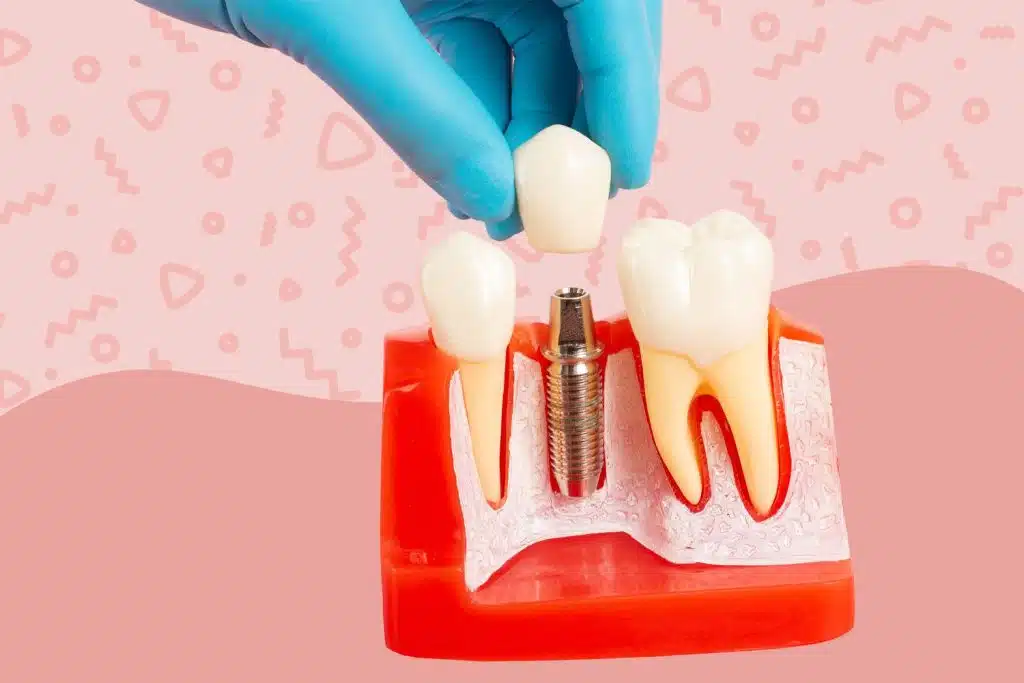
If your natural teeth have made an untimely exit due to an accident or tooth extraction, you may well be pondering the thought of dental implants. As beneficial as they may seem, though, the cost can make some balk at the thought.
Consequently, a key question often echoes: How to get dental implants covered by insurance? Fortunately, securing dental implant insurance to mitigate the financial burden of this procedure is not impossible.
Dental Implants and Insurance
Navigating dental implants and dental insurance plans can be complex, but understanding your coverage options can lead you to more affordable solutions. Some insurance companies may partially cover dental implants, but it’s essential to verify with your provider and understand their terms to avoid surprise expenditures.
Comparing dental insurance providers can also be beneficial, as some may have plans specially designed to cover dental implants. Regardless of your circumstances, with careful research and planning on various dental insurance plans, you can find affordable options.
The Dental Implant Procedure
Step 1: Consultation and Examination
This is the initial phase of the procedure, where your dentist evaluates your oral health. They may use X-rays or a CT scan to assess the health and structure of your jawbone. It determines the precise location of the implant placement and helps visualize the dental anatomy.
Step 2: Treatment Plan
Based on the dental assessment, your dentist will draft a personalized treatment plan. This comprehensive plan outlines the complete procedure needed, the estimated timeline for the treatment, and the potential cost involved. It provides a roadmap for your journey towards your dental implant.
Step 3: Tooth Extraction
If the tooth in question is still present, it needs to be extracted. Depending on your particular case and your dentist’s advice, the dental implant may be placed immediately or might require a few weeks of healing post-extraction. Either way, this step paves the way for the incoming implant.
Step 4: Bone Grafting
In cases where the jawbone is not strong or thick enough to support an implant, a bone graft is necessary. It is a surgical procedure that augments your existing bone, providing a more solid foundation for the dental implant. This stage does require additional healing time.
Step 5: Implant Placement
Implant dentists then place a titanium post—the actual dental implant—into your jawbone. This procedure functions like a new tooth root and requires a healing period so that the implant fuses with the bone in a process called osseointegration. This healing process typically takes a few months.
Step 6: Placing the Abutment
Once the area around the implant has healed, a minor procedure is done where your dentist will attach the abutment to the dental implant. This piece will eventually hold the new tooth. The gums will need to heal after the abutment has been placed.
Step 7: Impression for Crown
After your gums have healed around the abutment, an impression of your mouth is taken. This impression is utilized to create a crown that fits flawlessly onto your specific abutment and blends with your natural teeth. This customized solution ensures a seamless look.
Step 8: Placement of the Crown
Once the customized crown is fabricated, it gets attached to the abutment. It can be either removable or fixed based on your preference and your dentist’s recommendation. This marks the end of your dental implant journey, leading to a healthy, radiant smile.
Navigating Your Insurance Policies
To understand how to get dental implants covered by insurance or by medical insurance, you first have to understand your policy. Dental insurance policies can vary greatly, and what is covered under one plan could be excluded under another.
Simple answers to these questions can save you from unexpected out-of-pocket costs:
- Does it cover implant treatments?
- Does the dental coverage extend to related procedures like bone grafting and tooth extractions required before the implant procedure?
- Does your medical insurance cover any aspect of your dental implant procedure?
- What is the waiting period before coverage kicks in?
How Much Do Dental Implants Cost With Insurance?
The cost of dental implants can vary significantly depending on your insurance coverage and the specifics of your dental plan. However, it is important to note that most insurance companies deem this dental procedure a “cosmetic solution” and do not typically cover the full expense. On average, implants can range from $1,500 to $6,000 per tooth, but the dental implant costs with insurance can reduce this.
To have a precise understanding of your expected costs, it is crucial to consult with your insurance provider and your dentist to discuss your policy benefits and the potential payment structure for any remaining balance.
Shaping Your Dental Plan and Maximizing Insurance Coverage
Dental implants can sometimes cause a financial strain as dental insurance companies often categorize implants as major procedures, typically only partially covered. Here’s how you can make sure to get the most out of your current or future insurance policies:
- Choose a dental plan that clearly states its coverage options for implants.
- Confirm that basic procedures like tooth extractions and primary treatments (implant surgery) are covered.
- Understand the annual maximum payout of your insurance plan. You’ll carry the additional cost if your treatment costs surpass this limit.
- Explore if your medical insurance can be tapped for certain aspects of your dental procedure.
- Ask your dentist to draft an extensive treatment plan outlining all potential costs. This could help you understand your overall pocket expense.
Dental Discount Plan and Monthly Payments
If the cost of implants remains daunting even after exhausting your dental insurance benefits, here are some alternative paths that could lead you to your end goal:
- A dental discount plan can be a perfect ally, as it could lend substantial discounts on various dental services.
- Consider discussing monthly payment or financing plans with your dental clinic. These options could distribute your costs over a longer period, lessening your immediate financial burden.
- Health savings or flexible spending accounts are useful tools to help offset the cost of your implants. Both accounts use pre-tax dollars, which can result in bigger savings.
- Some nonprofit organizations and charities help individuals finance their dental care. Researching local resources could help you reach your goal of securing dental implants.
Long-Term Benefits of Dental Implants
While addressing how to get dental implants covered by medical insurance or dental insurance, here are the long-term benefits that justify the initial expense:
- Improved quality of life
- Enhanced oral health
- Elimination of discomfort related to tooth loss
- Preventive care for remaining teeth and the oral structure
Redesign Your Smile: Reserve Your Seat at Our Implant Consultation
Navigating the sea of insurance terms and understanding how to secure maximum insurance benefits for your dental implant procedure may seem daunting. Yet, with thorough research, understanding your coverage limitations, and advocacy, you may find ways to mitigate the financial impact of the treatment. Dental implants are not strictly cosmetic procedures. They protect your oral health and significantly boost your quality of life.
Call us today to schedule your consultation for a dental implant surgery and reclaim your beautiful smile. Our dedicated team can assist you in understanding your dental insurance coverage and exploring different financing options to make your smile dreams a reality. You deserve the highest quality of dental care, and we are here to ensure you receive it.



